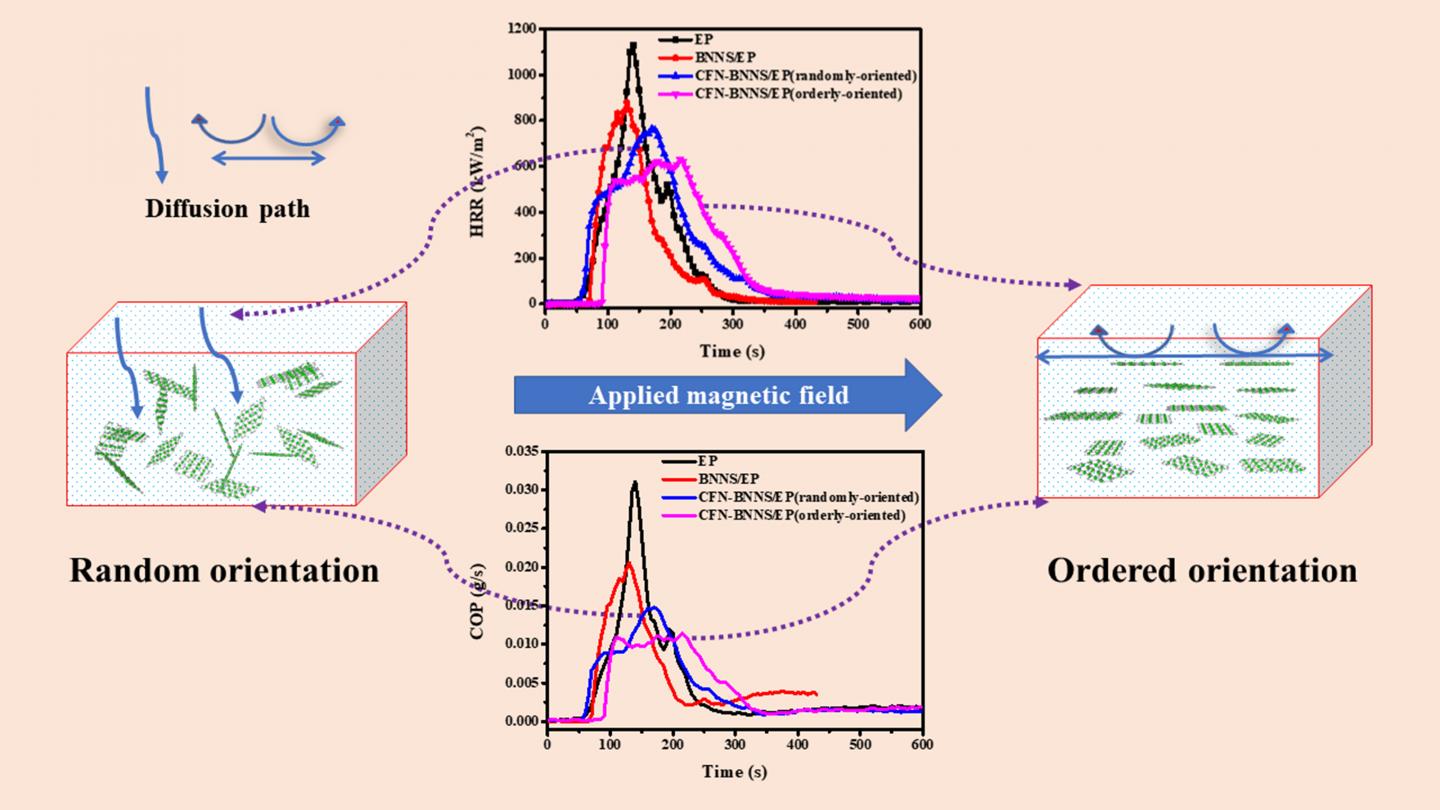
Credit: Dr. Qiaoran Zhang, Prof. Xiaohong Li, et al.
In a paper to be published in the forthcoming issue in NANO, a team of researchers from Henan University have investigated the flame retardant performance of epoxy resin using a boron nitride nanosheet decorated with cobalt ferrite nanoparticle.
Polymers are widely used in our daily lives due to good physical and chemical stability, corrosion resistance and other superior properties. However, most polymers, due to their organic nature, are inherently flammable which has a potential threat to the safety of human life and property. In order to avoid or reduce the flammability of polymers, it is a good strategy to add flame retardants to the polymers.
Among them, two-dimensional (2D) layered inorganic nanomateirals (nanosheets), represented by graphene oxide, molybdenum disulfide, and boron nitride nanosheets (BNNS), exhibit excellent flame retardant performance due to their good physical barrier effects. However, the flame retardance is not enough in the use of such 2D inorganic flame retardants alone, and in particular, the ability to suppress toxic gases and smoke is weak.
In this study, authors used cobalt ferrite nanoparticle (CFN) to decorate BNNS in order to obtain CFN-BNNS nanohybrids with good potential for reducing both the heat hazard and toxic hazard of epoxy resin (EP) composites, by making use of CFN synergistic effect. More importantly, the as-prepared CFN-BNNS has superior paramagnetic properties, thereby accommodating the ordered orientation of BNNS in EP matrix under a weak magnetic field that can act as a good physical barrier. The ordered alignment of the CFN-BNNS in EP contributes to better flame retardant performance compared with random one. Namely, the flame retardant performance of the 2D flame retardants can be improved by the ordered alignment under a weak magnetic field. This technology provides a new approach to improve flame retardant performance of 2D flame retardants in thermoset polymer. This is the most significant novelty. And it will help researchers design and produce more polymers with excellent flame retardant performance through this method.
###
This paper was supported by the National Natural Science Foundation of China (grant No. 21371050) and the Program for Innovative Research Team from the University of Henan Province (grant No. 17IRTSTHN004).
Additional co-authors of the Nano paper are Dr. Qiaoran Zhang, Prof. Xiaohong Li, Prof. Laigui Yu, Prof. Zhijun Zhang and Prof. Zhishe Wu, from Henan University. The corresponding authors for this study are Zhiwei Li ([email protected]) and Zhishen Wu ([email protected]).
For more insight into the research described, readers are invited to access the paper on NANO.
IMAGE
Caption: Cobalt ferrite nanoparticles decorated boron nitride nanosheets hybrid flame retardants were prepared through a simple solvothermal method. Subsequently, the orientation of the nanohybrids in epoxy resin was obtained under a rotating magnetic field. Due to enhancement of the barrier effect, the ordered alignment of the nanohybrids in epoxy resin contributes to better flame-retardant performance, compared with random one.
NANO is an international peer-reviewed monthly journal for nanoscience and nanotechnology that presents forefront fundamental research and new emerging topics. It features timely scientific reports of new results and technical breakthroughs and publishes interesting review articles about recent hot issues.
About World Scientific Publishing Co.
World Scientific Publishing is a leading independent publisher of books and journals for the scholarly, research, professional and educational communities. The company publishes about 600 books annually and about 135 journals in various fields. World Scientific collaborates with prestigious organizations like the Nobel Foundation and US National Academies Press to bring high quality academic and professional content to researchers and academics worldwide. To find out more about World Scientific, please visit http://www.
For more information, contact Tay Yu Shan at [email protected].
Media Contact
Yu Shan Tay
[email protected]
Original Source
https:/
Related Journal Article
http://dx.




